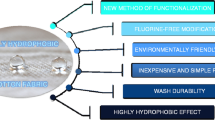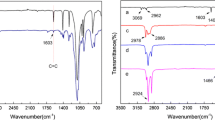Abstract
As part of this research, new halogen free organosilicon compounds were synthesized for the modification of natural fabrics. Difunctional polysiloxanes containing alkoxysilyl groups and silsesquioxane moieties in their structure were obtained by hydrosilylation or thiol-ene click reaction. Using two different reactions leading to the formation of polysiloxane derivatives, we demonstrate the influence of the chemical structure of the obtained polymers on the properties of modified cotton. The structure of the synthesized compounds was confirmed by FT-IR and NMR spectroscopy. After the synthesis of 6 different polysiloxane derivatives with different content of functional groups in their structures, they were applied to the natural fabrics in order to render them hydrophobic. The samples were modified via the dip-coating process. As a result of the research, superhydrophobic fabrics were obtained that are completely resistant to the process of repeated washing. The water repellency of the fabrics was assessed by measuring the water contact angle. The presence of the modifier on the fiber surface (before and after washing) was confirmed by FT-IR and SEM–EDS analysis. In addition, the surface of the modified fibers was examined using SEM images.
Graphical abstract
















Similar content being viewed by others
Data availability
Data available on request due to privacy restrictions. The data presented in this study are available on request from the corresponding author. The data are not publicly available due to the lack of availability of a suitable repository.
Code availability
Not applicable.
References
Bae GY, Min BG, Jeong YG, Lee SC, Jang JH, Koo GH (2009) Superhydrophobicity of cotton fabrics treated with silica nanoparticles and water-repellent agent. J Colloid Interface Sci 337:170–175. https://doi.org/10.1016/j.jcis.2009.04.066
Barczewski M, Dobrzyńska-Mizera M, Dutkiewicz M, Szołyga M (2016) Novel polypropylene β-nucleating agent with polyhedral oligomeric silsesquioxane core: synthesis and application. Polym Int 65:1080–1088. https://doi.org/10.1002/pi.5158
Beaumont M, Bacher M, Opietnik M, Gindl-Altmutter W, Potthast A, Rosenau T (2018) A general aqueous silanization protocol to introduce vinyl, mercapto or azido functionalities onto cellulose fibers and nanocelluloses. Molecules 23:1427. https://doi.org/10.3390/molecules23061427
Bentis A, Boukhriss A, Zahouily M, Manoun B, Gmouh S (2023) Functionalization of cotton fabrics by sol-gel method using ionic liquids with high-hydrophobic, excellent water repellent, oil/water separation, and self-cleaning properties. Cellulose 30:6719–6740. https://doi.org/10.1007/s10570-023-05276-8
Bołt M, Zak P, Dudziec B, Schulmann A, Marciniec B (2020) Formation of bifunctional octasilsesquioxanes via silylative coupling and cross-metathesis reaction. Materials 13:3966. https://doi.org/10.3390/ma13183966
Cook WD, Chen F, Dat Nghiem Q, Chausson QS, Le Pluart L (2010) Photo-plasticity in thiol-ene network polymers—A review. Macromol Symp 291–292:50–65. https://doi.org/10.1002/masy.201050507
Dąbek I, Kaczmarek M, Karasiewicz J, Guliński J, Maciejewski H (2020) Effective method for the production of anti-fog (dew-resistant) coatings based on bifunctional polysiloxanes. Polymers 65:807–815. https://doi.org/10.14314/polimery.2020.11.8
Dong C, Lu Z, Zhang F, Zhu P, Zhang L, Sui S (2015) Preparation and properties of cotton fabrics treated with a novel polysiloxane water repellent and flame retardant. Mater Lett 152:276–279. https://doi.org/10.1016/j.matlet.2015.03.132
Dutkiewicz M, Szołyga M, Maciejewski H, Marciniec B (2014) Thiirane functional spherosilicate as epoxy resin modifier: Synthesis and thermal stability. J Therm Anal Calorim 117:259–264. https://doi.org/10.1007/s10973-014-3725-3
Ganicz T, Kowalewska A, Stańczyk WA, Nye SA, Rubinsztajn S (2005) A novel organometallic route to phenylethenyl-modified polysiloxanes. J Mater Chem 15:611–619. https://doi.org/10.1039/B413474E
Guo R, Liu Y, Zhou L, Zhou Z, Li Q (2020) Synthesis and properties of thermoplastic and dissolvable polysiloxanes containing polyhedral oligomeric silsesquioxane. J Polym Sci 58:3183–3195. https://doi.org/10.1002/pol.20199265
Hettegger H, Beaumont M, Potthast A, Rosenau T (2016) Aqueous modification of nano-and microfibrillar cellulose with a click synthon. Chemsuschem 9:75–79. https://doi.org/10.1002/cssc.201501358
Hoyle CE, Bowman CN (2010) Thiol-ene click chemistry. Angew Chem Int Ed Engl 49:1540–1573. https://doi.org/10.1002/anie.200903924
Huang C, Zhang N, Wang Q, Wang P, Yu Y, Zhou M (2021) Development of hydrophilic anti-crease finishing method for cotton fabric using alpha-Lipoic acid without causing strength loss and formaldehyde release problem. Prog Org Coat 151:106042. https://doi.org/10.1016/j.porgcoat.2020.106042
Kanjana N, Ruangjan S, Kotsarn N, Ratchathani R, Laokul P (2023) Multifunctional fluorine-free cotton fabrics modified by AgBr–TiO2/OV-POSS nanocomposites. Cellulose 30:2503–2527. https://doi.org/10.1007/s10570-022-04985-w
Li W, Liu H (2013) Design and preparation of SQ-based superhydrophobic coatings with different substituents for multifunctional applications. Surf Coat Technol 457:129285. https://doi.org/10.1016/j.surfcoat.2023.129285
Li G, Wang L, Ni H, Pittman CU Jr (2001) Polyhedral oligomeric silsesquioxane (POSS) polymers and copolymers: a review. J Inorg Organomet Polym Mater 11:123–154. https://doi.org/10.1023/A:1015287910502
Li X, Tabil LG, Panigrahi S (2007) Chemical treatments of natural fiber for use in natural fiber-reinforced composites: a review. J Polym Environ 15:25–33. https://doi.org/10.1007/s10924-006-0042-3
Lin TC, Lee DJ (2021) Cotton fabrics modified for use in oil/water separation: a perspective review. Cellulose 28:4575–4594. https://doi.org/10.1007/s10570-021-03850-6
Liu J, Dong C, Zhang Z, Kong D, Sun H, Lu Z (2020) Multifunctional flame-retarded and hydrophobic cotton fabrics modified with a cyclic phosphorus/polysiloxane copolymer. Cellulose 27:3531–3549. https://doi.org/10.1007/s10570-020-03016-w
Liu J, Zhang Z, Sun L, Dong C, Kong D, Wang S, Lu Z (2021) Synthesis of a novel synergistic flame retardant based on cyclopolysiloxane and its flame retardant coating on cotton fabric. Cellulose 28:9505–9523. https://doi.org/10.1007/s10570-021-04127-8
Lowe AB (2010) Thiol-ene “click” reactions and recent applications in polymer and materials synthesis. Polym Chem 1:17–36. https://doi.org/10.1039/B9PY00216B
Lu Z, Liu J, Dong C, Zhang Z, Wei D (2019) Durable multifunctional antibacterial and hydrophobic cotton fabrics modified with linear fluorinated pyridinium polysiloxane. Cellulose 26:7483–7494. https://doi.org/10.1007/s10570-019-02582-y
Maciejewski H, Karasiewicz J, Dutkiewicz A, Dutkiewicz M, Dopierała K, Prochaska K (2014) Synthesis and properties of polysiloxanes containing mixed functional groups. React Funct Polym 83:144–154. https://doi.org/10.1016/j.reactfunctpolym.2014.07.019
Makowski T (2020) Hydrophobization of cotton fabric with silanes with different substituents. Cellulose 27:1–9. https://doi.org/10.1007/s10570-019-02776-4
Mituła K, Duszczak J, Rzonsowska M, Żak P, Dudziec B (2020) Polysiloxanes grafted with mono (alkenyl) silsesquioxanes—particular concept for their connection. Materials 13:4784. https://doi.org/10.3390/ma13214784
Mituła K, Januszewski R, Duszczak J, Rzonsowska M, Dudziec B (2022) High thermally stable polysiloxanes cross-linked with di(alkenyl) functionalized DDSQs exhibiting swelling abilities. Eur Polm J 171:111191. https://doi.org/10.1016/j.eurpolymj.2022.111191
Nakajima Y, Shimada S (2015) Hydrosilylation reaction of olefins: recent advances and perspectives. RSC Adv 5:20603–20616. https://doi.org/10.1039/C4RA17281G
Periolatto M, Ferrero F, Montarsolo A, Mossotti R (2013) Hydrorepellent finishing of cotton fabrics by chemically modified TEOS based nanosol. Cellulose 20:355–364. https://doi.org/10.1007/s10570-012-9821-2
Przybylak M, Maciejewski H, Dutkiewicz A (2016a) Preparation of highly hydrophobic cotton fabric by modification with bifunctional silsesquioxanes in the sol-gel process. Appl Surf Sci 387:163–174. https://doi.org/10.1016/j.apsusc.2016.06.094
Przybylak M, Maciejewski H, Dutkiewicz A, Dąbek I, Nowicki M (2016b) Fabrication of superhydrophobic cotton fabrics by a Simple chemical modification. Cellulose 23:2185–2197. https://doi.org/10.1007/s10570-016-0940-z
Przybylak M, Maciejewski H, Dutkiewicz A, Wesołek D, Władyka-Przybylak M (2016c) Multifunctional, strongly hydrophobic and flame-retarded cotton fabrics modified with flame retardant agents and silicon compounds. Polym Degr Stabil 128:55–64. https://doi.org/10.1016/j.polymdegradstab.2016.03.003
Przybylak M, Maciejewski H, Dutkiewicz A, Foksowicz-Flaczyk J, Walentowska J (2018) Development of multifunctional cotton fabrics using difunctional polysiloxanes. Cellulose 25:1483–1497. https://doi.org/10.1007/s10570-017-1621-2
Przybylak M, Szymańska A, Maciejewski H, Makowska K (2020) Durable, highly hydrophobic modification of cotton fabric with fluorine-free polysiloxanes obtained via hydrosilylation and hydrothiolation reactions. Cellulose 27:8351–8367. https://doi.org/10.1007/s10570-020-03341-0
Qian F, Zheng Y, Pan N, Li L, Li R, Ren X (2021) Synthesis of polysiloxane and its co-application with nano-SiO2 for antibacterial and hydrophobic cotton fabrics. Cellulose 28:3169–3181. https://doi.org/10.1007/s10570-021-03704-1
Roy D, Semsarilar M, Guthrie JT, Perrier S (2009) Cellulose modification by polymer grafting: A review. Chem Soc Rev 38:2046–2064. https://doi.org/10.1039/B808639G
Szołyga M, Dutkiewicz M, Nowicki M, Sałasińska K, Celiński M, Marciniec B (2020) Phosphorus-containing silsesquioxane derivatives as additive or reactive components of epoxy resins. Materials 13:5373. https://doi.org/10.3390/ma13235373
Szymańska A, Przybylak M, Maciejewski H, Przybylska A (2022) Thiol-ene chemistry as an effective tool for hydrophobization of cotton fabrics. Cellulose 29:1231–1247. https://doi.org/10.1007/s10570-021-04357-w
Textor T, Mahltig B (2010) A sol-gel based surface treatment for preparation of water repellent antistatic textiles. Appl Surf Sci 256:1668–1674. https://doi.org/10.1016/j.apsusc.2009.09.091
Troegel D, Stohrer J (2011) Recent advances and actual challenges in late transition metal catalyzed hydrosilylation of olefins from an industrial point of view. Coord Chem Rev 255:1440–1459. https://doi.org/10.1016/j.ccr.2010.12.025
Wang W, Wang J, Wang X, Wang S, Liu X, Qi P, Gu X (2020) Improving flame retardancy and self-cleaning performance of cotton fabric via a coating of in-situ growing layered double hydroxides (LDHs) on polydopamine. Prog Org Coat 149:105930. https://doi.org/10.1016/j.porgcoat.2020.105930
Xie K, Yu Y, Liu H (2010) Modification and dispersion of the polysiloxane materials with perfluorocarbon groups and cationic side chains. J Dispers Sci Techno 31:1344–1349. https://doi.org/10.1080/01932690903227675
Xu F, Zhong L, Xu Y, Zhang C, Zhang F, Zhang G (2019) Highly efficient flame-retardant and soft cotton fabric prepared by a novel reactive flame retardant. Cellulose 26:4225–4240. https://doi.org/10.1007/s10570-019-02374-4
Xue CH, Ji PT, Zhang P, Li YR, Jia ST (2013) Fabrication of superhydrophobic and superoleophilic textiles for oil–water separation. Appl Surf Sci 284:464–471. https://doi.org/10.1016/j.apsusc.2013.07.120
Xue CH, Fan QQ, Guo XJ, An QF, Jia ST (2019) Fabrication of superhydrophobic cotton fabrics by grafting of POSS-based polymers on fibers. Appl Surf Sci 465:241–248. https://doi.org/10.1016/j.apsusc.2018.09.156
Yang M, Liu W, Liang L, Jiang C, Liu C, Xie Y, Pi K (2020) A mild strategy to construct superhydrophobic cotton with dual self-cleaning and oil–water separation abilities based on TiO 2 and POSS via thiol-ene click reaction. Cellulose 27:2847–2857. https://doi.org/10.1007/s10570-019-02963-3
Zaghloul S, Sharaf S, Ameduri B, Hebeish A (2020) Novel fluorinated compound for imparting sustainable functionalities to cellulose-containing substrates. Cellulose 27:629–641. https://doi.org/10.1007/s10570-019-02802-5
Acknowledgments
The research was funded by the National Science Center, Poland (UMO-2020/37/B/ST5/03266)
Author information
Authors and Affiliations
Contributions
Performed cotton fabrics modifications and wrote the manuscript, performed fabric analyzes and interpreted the results—M. P.; synthesized and characterized the obtained compounds—thiol-ene click reaction, participated in writing the manuscript—M. SZ.; provided guidance during the planning of experiments and reviewed the manuscript—H. M.
Corresponding author
Ethics declarations
Conflict of interest
The authors have no relevant financial or non-financial interests to disclose.
Ethical approval
This article does not contain any studies with human participants or animals performed by any of the authors.
Consent to participate
All authors gave explicit consent to participate.
Consent for publication
All authors gave explicit consent to submit.
Additional information
Publisher's Note
Springer Nature remains neutral with regard to jurisdictional claims in published maps and institutional affiliations.
Supplementary Information
Below is the link to the electronic supplementary material.
Rights and permissions
Springer Nature or its licensor (e.g. a society or other partner) holds exclusive rights to this article under a publishing agreement with the author(s) or other rightsholder(s); author self-archiving of the accepted manuscript version of this article is solely governed by the terms of such publishing agreement and applicable law.
About this article
Cite this article
Przybylak, M., Szołyga, M. & Maciejewski, H. Superhydrophobic cotton fabrics: a quick and easy method of modification. Cellulose 31, 3303–3320 (2024). https://doi.org/10.1007/s10570-024-05811-1
Received:
Accepted:
Published:
Issue Date:
DOI: https://doi.org/10.1007/s10570-024-05811-1




